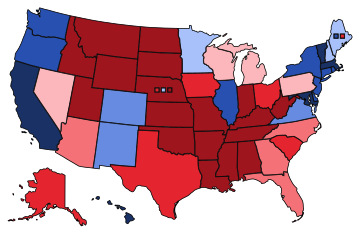Since Colorado became a U.S. state in 1876, it has sent congressional delegations to the United States Senate and United States House of Representatives. Each state elects two senators to serve for six years, and members of the House to two-year terms. Before becoming a state, the Colorado Territory elected a non-voting delegate at-large to Congress from 1861 to 1876.

Political party strength in U.S. states is the level of representation of the various political parties in the United States in each statewide elective office providing legislators to the state and to the U.S. Congress and electing the executives at the state and national level.
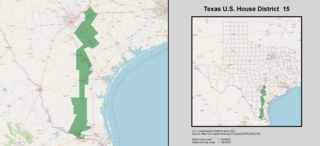
Texas's 15th congressional district of the United States House of Representatives includes a thin section of the far south of the state of Texas. The district's current Representative is Republican Monica De La Cruz. Elected in 2022, de la Cruz is the first Republican and woman to represent the district.

Texas's 19th congressional district of the United States House of Representatives includes the upper midwestern portion of the state of Texas. The district includes portions of the State from Lubbock to Abilene. The current Representative from the 19th district is Republican Jodey Arrington. With a Cook Partisan Voting Index rating of R+26, it is one of the most Republican districts in the United States.
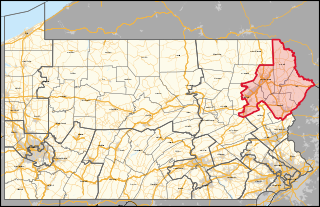
Pennsylvania's 8th congressional district is located in the northeastern region of the state. It encompasses all of Wayne, Pike, and Lackawanna Counties; along with portions of Luzerne and Monroe counties.

Maryland's 1st congressional district encompasses the entire Eastern Shore of Maryland, including Salisbury, as well as Harford County and parts of Baltimore County; it is the largest congressional district in the state geographically, covering 11 counties.
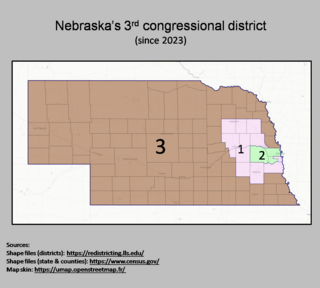
Nebraska's 3rd congressional district is a congressional district in the U.S. state of Nebraska that encompasses its western three-fourths; it is one of the largest non-at-large districts in the country, covering nearly 65,000 square miles (170,000 km2), two time zones and 68 counties. It includes Grand Island, Kearney, Hastings, North Platte, Alliance, and Scottsbluff. Additionally, it encompasses the Sandhills region and a large majority of the Platte River. With a Cook Partisan Voting Index rating of R+29, it is the most Republican district in Nebraska, a state with an all-Republican delegation.

Kentucky's 3rd congressional district is a congressional district in the U.S. state of Kentucky. It encompasses almost all of Louisville Metro, which, since the merger of 2003, is consolidated with Jefferson County, though other incorporated cities exist within the county, such as Shively and St. Matthews. The far eastern portions of Louisville Metro are part of the 2nd congressional district.
Alabama's 4th congressional district is a U.S. congressional district in Alabama, which elects a representative to the United States House of Representatives. It encompasses the counties of Franklin, Colbert, Marion, Lamar, Fayette, Walker, Winston, Cullman, Lawrence, Marshall, Etowah, and DeKalb. It also includes parts of Jackson and Tuscaloosa counties, as well as parts of the Decatur Metropolitan Area and the Huntsville-Decatur Combined Statistical Area.

Kentucky's 5th congressional district is a congressional district in the U.S. state of Kentucky. Located in the heart of Appalachia in Southeastern Kentucky, it represents much of the Eastern Kentucky Coalfield. The rural district is the second most impoverished district in the nation and, as of the 2010 U.S. census, has the highest percentage of White Americans in the nation. It contains the counties of Bell, Boyd, Breathitt, Clay, Elliot, Floyd, Harlan, Jackson, Johnson, Knott, Knox, Laurel, Lawrence, Lee, Lincoln, Leslie, Letcher, Magoffin, Martin, McCreary, Menifee, Morgan, Owsley, Perry, Pike, Pulaski, Rockcastle, Rowan, Wayne, Whitley, Wolfe, and parts of Bath, and Carter counties. Within the district are the economic leading cities of Ashland, Pikeville, Prestonsburg, Middlesboro, Hazard, Jackson, Morehead, London, and Somerset. It is the most rural district in the United States, with 76.49% of its population in rural areas. It has been represented by Republican Hal Rogers since 1981.
Washington's 4th congressional district encompasses a large area of central Washington, covering the counties of Douglas, Okanogan, Grant, Yakima, Benton, and Klickitat; and parts of Adams and Franklin counties. The district is dominated by the Yakima and Tri-Cities areas. With a Cook Partisan Voting Index rating of R+11, it is the most Republican district in Washington.
Michigan's 12th congressional district is a U.S. congressional district in Michigan.

The 5th congressional district of Illinois covers parts of Cook and Lake counties, as of the 2023 redistricting which followed the 2010 census. All or parts of Chicago, Inverness, Arlington Heights, Barrington Hills, Des Plaines, Palatine, Mount Prospect, Deer Park, Kildeer, Lake Zurich, Long Grove, and North Barrington are included.

Arkansas's 2nd congressional district is a congressional district located in the central part of the U.S. state of Arkansas and includes the state capital of Little Rock, its suburbs, and surrounding areas. The district leans Republican, with a Cook Partisan Voting Index rating of R+9. However, due to the influence of heavily Democratic Little Rock, it is still considered the least Republican congressional district in Arkansas, which has an all-Republican congressional delegation.

Pennsylvania's 9th congressional district is located in the east central part of the state and encompasses all of Bradford, Columbia, Lebanon, Montour, Northumberland, Schuylkill, Sullivan, Susquehanna, and Wyoming counties, as well as parts of Berks, Luzerne, and Lycoming counties.

Oklahoma's 5th congressional district is a congressional district in the U.S. state of Oklahoma. It borders all of the other congressional districts in the state except the 1st district. It is densely populated and covers most of Oklahoma County and all of Lincoln, Pottawatomie and Seminole counties, as well as parts of Canadian and Logan counties. With a Cook Partisan Voting Index rating of R+12, it is the least Republican district in Oklahoma, a state with an all-Republican congressional delegation.
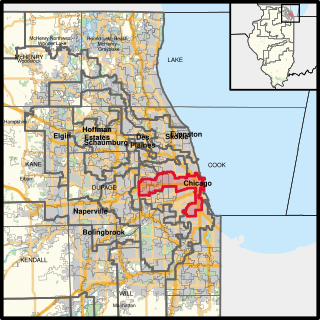
The 7th congressional district of Illinois covers parts of Cook County, as of the 2023 redistricting that followed the 2020 census. All or parts of Broadview, Bellwood, Chicago, Forest Park, Hillside, Oak Park, La Grange Park, Maywood, and Westchester are included. Democrat Danny K. Davis has represented the district since January 1997. With a Cook Partisan Voting Index rating of D+36, it is the most Democratic district in Illinois.

The 2008 United States House election in Delaware was held on November 4, 2008, to determine who will represent the state of Delaware in the United States House of Representatives for the 111th Congress, coinciding with the presidential election. The primary election was held on September 9, 2008.
Utah's 4th congressional district is a congressional district created by the state legislature as a result of reapportionment by Congress after the 2010 census showed population increases in the state relative to other states. Prior to 2010 reapportionment, Utah had three congressional districts.
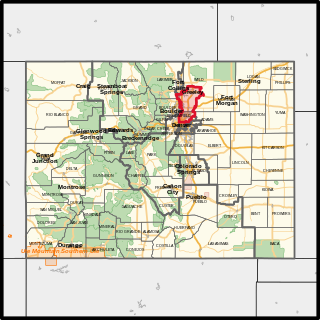
Colorado's 8th congressional district is a new district in the United States House of Representatives that was apportioned after the 2020 United States census. The first congressional seat to be added to Colorado's congressional delegation since 2001, the 8th district was drawn before the 2022 elections. The district was drawn by the Colorado Independent Redistricting Commission and approved in an 11–1 vote on September 28, 2021, before being approved unanimously by the Colorado Supreme Court on November 1, 2021.
